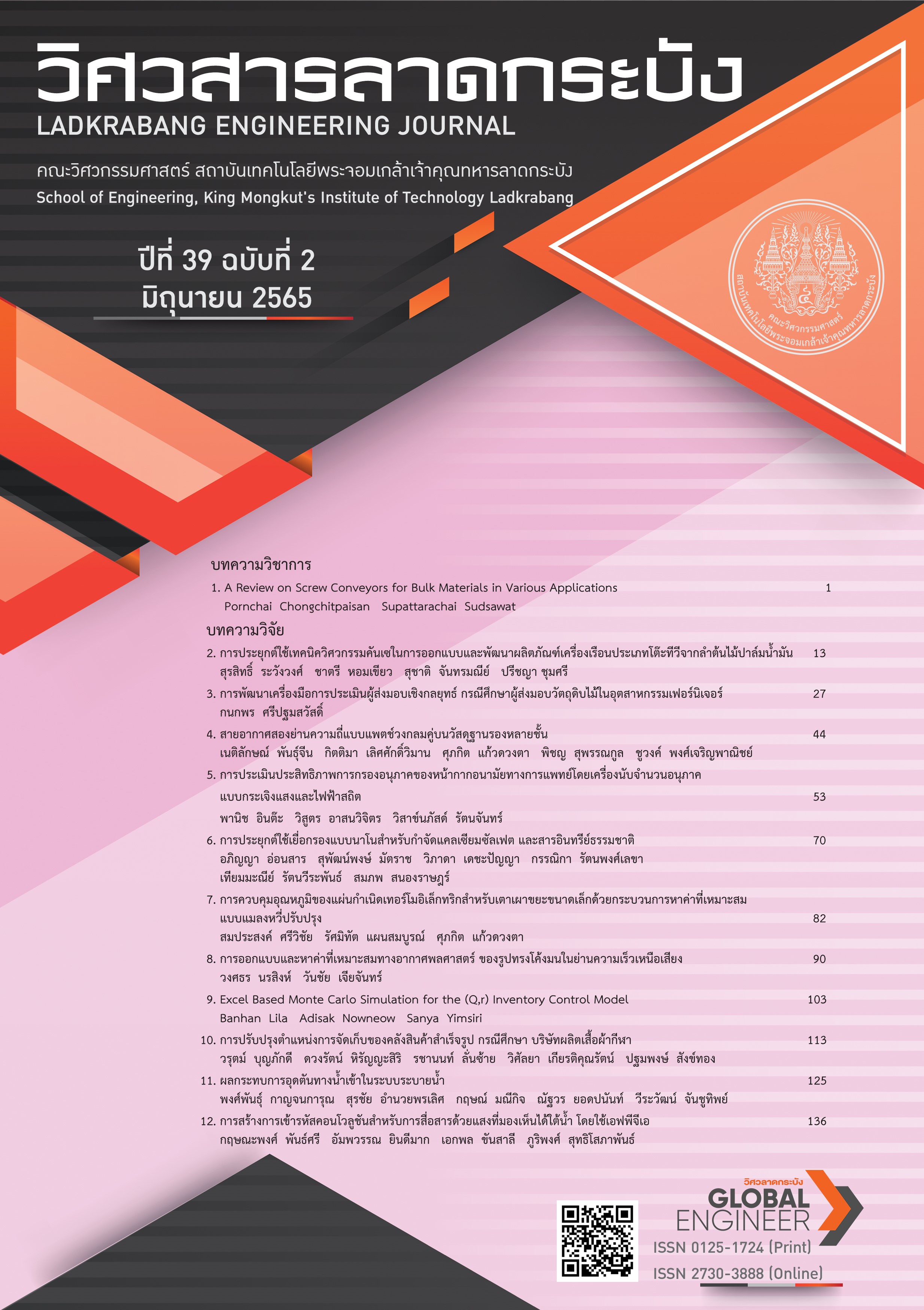การประยุกต์ใช้เทคนิควิศวกรรมคันเซในการออกแบบและพัฒนาผลิตภัณฑ์เครื่องเรือนประเภทโต๊ะทีวีจากลำต้นไม้ปาล์มน้ำมัน
คำสำคัญ:
การพัฒนาผลิตภัณฑ์, โต๊ะทีวี, วิศวกรรมคันเซ, ลำต้นไม้ปาล์มน้ำมัน, การออกแบบผลิตภัณฑ์บทคัดย่อ
งานวิจัยนี้มีวัตถุประสงค์เพื่อประยุกต์ใช้เทคนิควิศวกรรมคันเซสำหรับออกแบบและพัฒนาผลิตภัณฑ์เครื่องเรือนประเภทโต๊ะทีวีจากลำต้นไม้ปาล์มน้ำมัน ให้เกิดแนวคิดการพัฒนาผลิตภัณฑ์ที่สามารถตอบสนองความต้องการของผู้บริโภคผ่านการวิเคราะห์เชิงปริมาณประเภทที่ 1 (การถดถอยเชิงเส้นพหุคูณ) ที่ได้จากการสำรวจด้วยการประเมินคะแนนแบบลิเคิร์ตสเกลให้อยู่ในรูปแบบของสมการพยากรณ์สำหรับแสดงความสัมพันธ์ระหว่างคำแสดงความรู้สึกกับคุณลักษณะผลิตภัณฑ์ และสำหรับจำลองรูปแบบผลิตภัณฑ์ใหม่ ผลการวิเคราะห์เชิงปริมาณประเภทที่ 1 พบว่าสามารถกำหนดคุณลักษณะผลิตภัณฑ์สำหรับการออกแบบผลิตภัณฑ์ จำนวน 5 คุณลักษณะผลิตภัณฑ์ ประกอบด้วย การใช้งาน รูปทรง วัสดุตกแต่ง ขนาด และรูปแบบผลิตภัณฑ์ อีกทั้งพบว่าสามารถกำหนดคำแสดงความรู้สึกที่แสดงความสัมพันธ์กับคุณลักษณะผลิตภัณฑ์สำหรับการออกแบบ ได้แก่ รับน้ำหนัก ประโยชน์ใช้สอย รูปร่าง เนื้อที่ใช้สอย หรูหรา สวยงาม และเอกลักษณ์ ดังนั้นผลงานวิจัยในครั้งนี้สามารถเป็นแนวทางช่วยให้นักออกแบบสามารถกำหนดคุณลักษณะผลิตภัณฑ์ที่แสดงถึงความสัมพันธ์กับความรู้สึกที่เหมาะสมสำหรับการออกแบบและพัฒนาผลิตภัณฑ์ใหม่ให้มีความสอดคล้องกับความต้องการของผู้บริโภคได้
References
P. Natakueatung, A. Sareebut and S. Egwutvongsa, “Study and Design of Products from Palm Fiber,” Journal of Industrial Education, vol. 14, no. 2, pp. 613–621, 2015.
S. Noothimthong, K. Kunta, and W. Poochinda, “Sustainable Oil Palm Production in Accordance with RSPO Standards,” Journal of Vocational Institute of Agricultural, vol. 4, no. 2, pp. 1–14, 2020.
Classified by Age Range: Perennial Area Fruiting Area, Yield and Yield per Fruiting Area Separated by Age Including Country, Region and Province in 2019, Office of Agricultural Economics Thailand, Nov. 1, 2021 [Online]. Available: shorturl.asia/0F63P
A. Suzianti and A. Aldianto, “Redesign of Product Packaging with Kansei Engineering: Empirical Study on Small-Medium Enterprises in Indonesia,” Makara Journal of Technology, vol. 24, no. 2, pp. 65–71, 2020, doi: 10.7454/mst.v24i2.2990.
S. Schütte, “Designing Feelings into Products: Integrating Kansei Engineering Methodology in Product Development,” Ph.D. dissertation. Dept., Mech Eng., Linkopings Univ., Linkopings, Sweden, 2002.
M. C. Chen, K. C. Chang, C. L. Hsu and J. H. Xiao, “Applying a Kansei Engineering-Based Logistics Service Design Approach to Developing International Express Services,” International Journal of Physical Distribution & Logistics Management, vol. 45, no. 6, pp. 618–646, 2015, doi: 10.1108/IJPDLM-10-2013-0251.
S. Yodwangjai, “Product Design and Development for Dinner Chair of Kansei Engineering,” KKU Engineering Journal, vol. 41, no. 2, pp. 191–200, 2014.
J. Pitaktiratham, T. Sinlan, P. Anuntavoranich and S. Sinthupinyo, “Application of Kansei Engineering and Association Rules Mining in Product Design,” International Journal of Economics and Management Engineering, vol. 69, pp. 198–203, 2012, doi: 10.5281/zenodo.1081675.
R. Roy, M. Goatman and K. Khangura, “User-centric design and Kansei Engineering,” CIRP Journal of Manufacturing Science and Technology, vol. 1, no. 3, pp. 172–178, 2009, doi: 10.1016/j.cirpj.2008.10.007.
K. Pimapunsri, “New Product Development Using Kansei Engineering,” in the 2nd National Conference on Industrial Operations Development, Bangkok, Thailand, May 11, 2011, pp. 331–337.
S. Schütte, “Developing the Space of Product Properties Supporting Kansei Engineering Procedure,” Kansei Engineering International, vol. 5, no. 4, pp. 11–19, 2006, doi: 10.5057/kei.5.4_11.
K. Prayoonwong, “Application of Kansei Engineering for New Product Development: Conceptual Wardrobe
Product Design,” M.E. Thesis, Dept. Ind. Eng., King Mongkut's University of Technology North Bangkok, Bangkok, Thailand, 2012.
S. H. Lee, A. Harada and P. J., Stappers. “Design based on Kansei,” in Pleasure with Products, Copenhagen, Denmark: Taylor & Francis, 2002, ch. 16, pp. 212–222.
A. Ongiem and P. Vichitvejpaisal, “Validation of the Tests,” Thai Journal of Anesthesiol, vol. 44, no. 1, pp. 36–42, 2018.
N. Kongprasert, “Emotional Design Approach to Design Teak Wood Furniture,” The 13th The Asia Pacific Industrial Engineering & Management Systems Conference, Phuket, Thailand, Dec. 2–5, 2012, pp. 805–812.
S. Rawangwong, C. Homkhiew, P. Phanthasri and P. Chumsri, “Design and Development of Krajood Decorations Products Using Kansei Engineering Technique and Kano’s Model,” UBU Engineering Journal, vol. 14, no. 4, pp. 181–193, 2021.
Downloads
เผยแพร่แล้ว
How to Cite
ฉบับ
บท
License
Copyright (c) 2022 คณะวิศวกรรมศาสตร์ สถาบันเทคโนโลยีพระจอมเกล้าเจ้าคุณทหาร

This work is licensed under a Creative Commons Attribution-NonCommercial-NoDerivatives 4.0 International License.
บทความที่ได้รับการตีพิมพ์เป็นลิขสิทธิ์ของคณะวิศวกรรมศาสตร์ สถาบันเทคโนโลยีพระจอมเกล้าเจ้าคุณทหารลาดกระบัง
ข้อความที่ปรากฏในบทความแต่ละเรื่องในวารสารวิชาการเล่มนี้เป็นความคิดเห็นส่วนตัวของผู้เขียนแต่ละท่านไม่เกี่ยวข้องกับสถาบันเทคโนโลยีพระจอมเกล้าเจ้าคุณทหารลาดกระบัง และคณาจารย์ท่านอื่นๆในสถาบันฯ แต่อย่างใด ความรับผิดชอบองค์ประกอบทั้งหมดของบทความแต่ละเรื่องเป็นของผู้เขียนแต่ละท่าน หากมีความผิดพลาดใดๆ ผู้เขียนแต่ละท่านจะรับผิดชอบบทความของตนเองแต่ผู้เดียว






